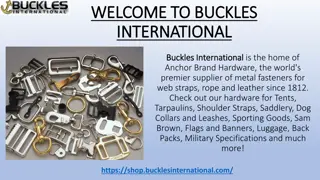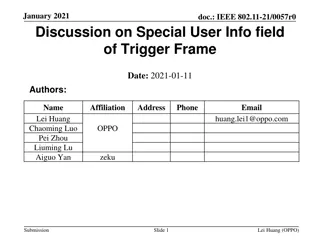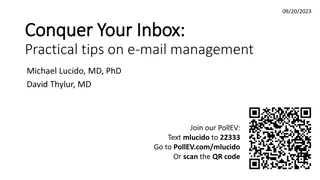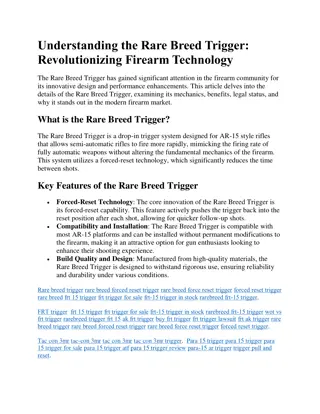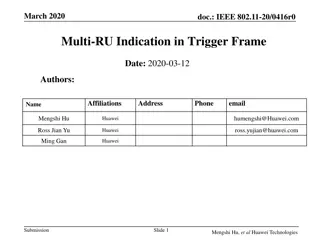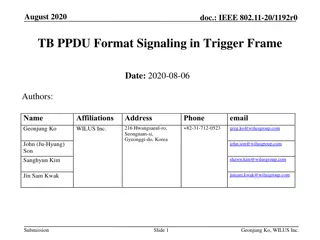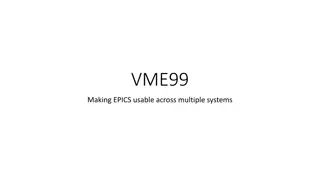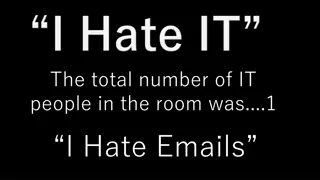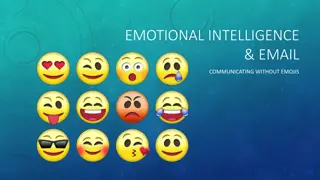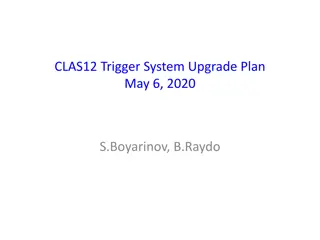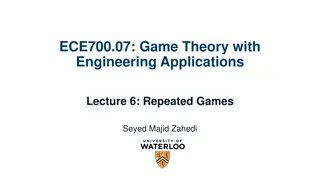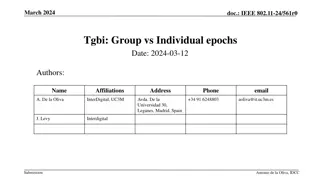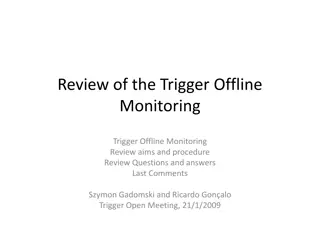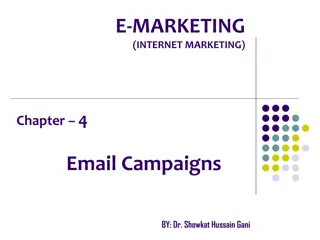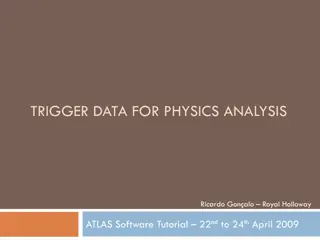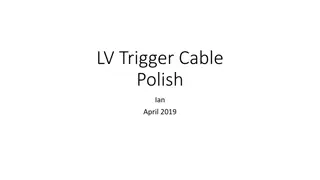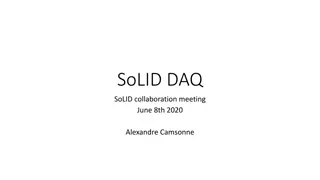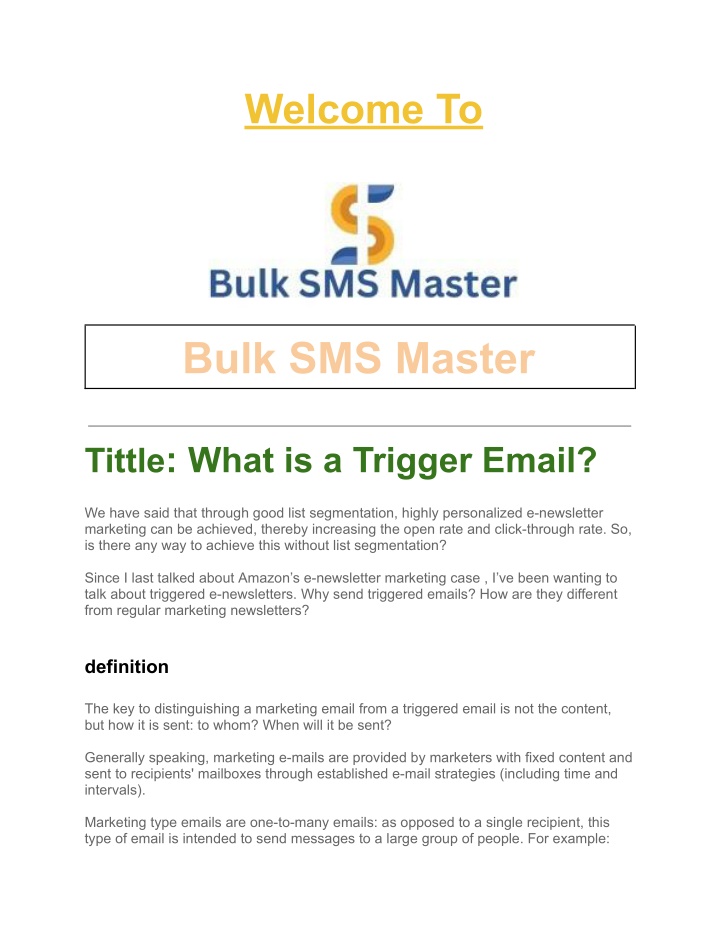
What is a Trigger Email
SMS Promotional Campaign | Bulk SMS Master nMeta Description: SMS Promotional Campaign is very much necessary for an effective SMS marketing, Bulk SMS Master offers various packages for this purpose.
Download Presentation

Please find below an Image/Link to download the presentation.
The content on the website is provided AS IS for your information and personal use only. It may not be sold, licensed, or shared on other websites without obtaining consent from the author. If you encounter any issues during the download, it is possible that the publisher has removed the file from their server.
You are allowed to download the files provided on this website for personal or commercial use, subject to the condition that they are used lawfully. All files are the property of their respective owners.
The content on the website is provided AS IS for your information and personal use only. It may not be sold, licensed, or shared on other websites without obtaining consent from the author.
E N D
Presentation Transcript
Welcome To Bulk SMS Master Tittle: What is a Trigger Email? We have said that through good list segmentation, highly personalized e-newsletter marketing can be achieved, thereby increasing the open rate and click-through rate. So, is there any way to achieve this without list segmentation? Since I last talked about Amazon s e-newsletter marketing case , I ve been wanting to talk about triggered e-newsletters. Why send triggered emails? How are they different from regular marketing newsletters? definition The key to distinguishing a marketing email from a triggered email is not the content, but how it is sent: to whom? When will it be sent? Generally speaking, marketing e-mails are provided by marketers with fixed content and sent to recipients' mailboxes through established e-mail strategies (including time and intervals). Marketing type emails are one-to-many emails: as opposed to a single recipient, this type of email is intended to send messages to a large group of people. For example:
product promotions, meeting attendance notifications, new feature releases. Triggered newsletter In the past, the most common triggered emails were receipts, order confirmations, etc. As usage patterns and needs change, there are more and more types of triggered e-newsletters. From the user's interaction with the web app, including registration, changing password, logging in, prompts, adding friends or someone following you, can be used as trigger points to send e-newsletters. Because of this feature, triggered e-newsletters can capture all online touch points. Triggered e-mails are a type Bulk SMS Service of transactional emails : letters sent to a single recipient. It is usually triggered based on the recipient's actions, such as: invoice winning, successful registration, order establishment, welcome letter. Marketing e-newsletter For example, using a common store sales metaphor, marketing e-newsletters convey consistent messages, such as promoting brand concepts and special offers on TV, and consumers in need will come to your door. Triggered e-newsletters are like customer service personnel, helping customers find products that are suitable for them. In this situation, because the customer tells you through his behavior that he has specific needs or what kind of problems he is facing. Compared with providing discounts or
consumption reasons caused by marketing or topics, consumers will be more inclined to recognize the value of solving problems. According to a survey by Borrell Associates, Inc. and Merkleiv, 64% of consumers consider triggered newsletters to be the most valuable in their inboxes. Therefore, triggered e-newsletters can directly help increase sales on average, they can increase revenue by 2 to 5 times compared to general marketing e-newsletters. What is worth discussing is, how do consumers define what is valuable to them? Attract potential customers We can add a fan club link in the newsletter so that customers can like our Facebook or follow us on Twitter through the newsletter. It is best to add some moderate incentives to invite customers to "share" the newsletter, for example: sharing can be exchanged for discount coupons, etc. Similarly, try to share the web version of the e-newsletter on social networking sites to create some interactions to attract potential customers to subscribe, such as competitive mini-games or online quizzes to attract users to sign up. Subscriber focus Based on users' respective interests and preferences, send relevant advertising information and marketing messages, such as personalized themes, formats and writing
styles, to effectively increase the open rate of e-newsletters and the click-through rate of advertising links. For example: The New York Times e-newsletter has more than 30 categories of readers , and the overall open rate can reach as high as 70%. A/B Test Use A/B testing to test different titles, images, and formats of the e-newsletter, conduct comparative analysis, and find the result with the highest open rate or link clicks, and use it in posts on social networking sites. Of course , we can also send the most popular and well-received posts on social networking sites to subscribers through e-newsletters. Interface optimization 60% of consumers read e-newsletters via mobile devices , so improving the readability of all information on mobile devices is a key priority. Pay attention to the layout of the article so that the text and images can be seen at a glance in different browsing vehicles, so that users can easily read the content in any interface. If marketers engaged in social media want to increase the number of followers or find no obvious benefits in running a fan page, they may wish to combine e-newsletters, as the two complement each other. Through social media, potential customers can be added to the subscription list and e-newsletters can be sent to generate 1 + 1 > 2 benefits through multiple channels . Interactive relationships with customers can be maintained in e-newsletters and social media. E-newsletter marketing RFM practical application cases The general RFM indicators are: Recency (last consumption date), Frequency (consumption frequency), and Monetary (total consumption amount). This article uses the RFM model to analyze the effectiveness of e-newsletters. The indicator of Recency can be replaced by " the date of the last email opening " ; the indicator of Frequency uses " average email opening rate " or " average click-through rate " as the analysis indicator; due to this time The case list does not have the customer's consumption amount, so Monetary cannot be analyzed, but the two indicators R and F are used for analysis. The following are the R and F indicators set in this case , which are used as the conditions for list focus: R: Have you opened any letters recently? In this case, grouping is done using the presence or absence of open letters in the last 10 times .
F: Average letter opening rate. In this case, groups are grouped using an open rate greater than or equal to 22% . (The average letter opening rate for the entire list without grouping is 22%) Notice! Since each company's data is different, the grouping method must be adjusted based on the company's data. This article lists the three core concepts of RFM grouping and is highly recommended for reference. 1. Freeze List [R Low] First, pull out the list of emails that have not been opened in the past 10 times and define it as a " frozen list " . That is, the list of emails that have not been opened recently may have little interest in e-newsletters, or may not need e-newsletter services recently. Prediction: The group of people with the lowest open rate and the least worthy of investment. 2. VIP list [R high F high] Among the lists with open letters in the last 10 times, find the list with a higher open rate (>22%). These lists have recently opened letters, and the letter opening rate is very high, which means that they have been paying attention to us recently, and the frequency of attention is very high. It is judged that the content of our e-newsletter best meets the needs of these customers. Prediction: The highest open rate and the most
worthy of investment. 3. Ordinary list [R high F low] Then, among the lists with open letters in the last 10 times, find the list with a low open rate ( 22%). These lists have recently opened emails, but the open rate is not high, indicating that they may only be interested in certain e-newsletter content. Prediction: The letter opening rate is average, and e-newsletters can be optionally sent. 4. No information list [R, F no information] Excluding the above three sets of lists, the remaining lists are all unavailable lists. These people are most likely new to the list and do not have any behavioral information. Prediction: Without any behavioral data, prediction cannot be made. Keep sending letters, and after a period of time, when enough behavioral data has been accumulated, group them again. Contact Us Website: https://www.bulksmsmaster.com Telegram: https://t.me/latestdat Whatsapp: 639858085805 Phone: 639858085805 Email: info@bulksmsmaster.com Address: Blk 34 Lot 5 Easthomes 3 Subd Estefania, Bacolod City, Philippines,6100

